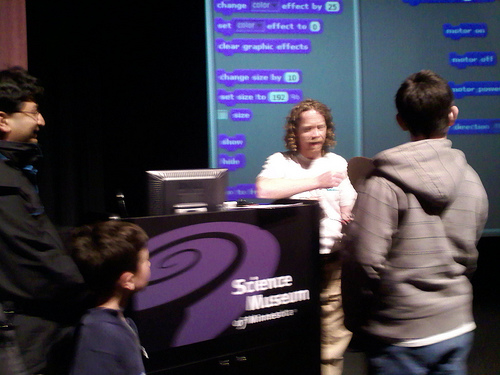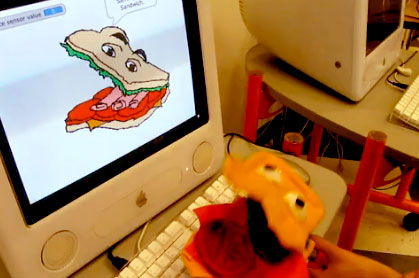Lifelong Learning: An Interview with Keith Braafladt about the Science Museum of Minnesota
Situated at the intersection of art, science, and technology, the Learning Technologies Center (LTC) at the Science Museum of Minnesota promotes Scratch as an accessible learning platform for all types of students. Keith Braafladt, Director of the LTC, has shared Scratch’s versatility with learners of all ages through various workshops and programs.

LTC’s enrichment programs take advantage of Scratch’s tinkerability, accommodating children in both fee-based and drop-in classes. “They are radically different, different conditions and different situations,” Keith says. Fee-based programs follow a predictable curriculum for a set amount of time while drop-in classes allow kids to come and go as often or as little as they want. “It’s very, very, very random. Scratch fell into that niche perfectly at a perfect time. We have kids truly explore Scratch and play in just a few minutes. If they stay, they can start to develop an animation, record a song, or start to develop a game.”
To demonstrate Scratch as a powerful and relevant tool for older students, Keith returned to his alma mater, hoping to influence the community at the Minneapolis College of Art and Design. “People try to trivialize Scratch as kid-like, so Scratch needs to work its way into colleges and universities.” Keith taught a course that, in the past, required students to learn Adobe Flash, but students working in group projects meant that only one member would gain real fluency in the technology, while the other students focused on other parts of the project. Keith’s own experience as an artist - an interest in interactive kinetic sculptures, combined with the availability of accessible tools, has led him to integrate physical objects into his syllabus. He broke the semester into three parts: purely screen-based projects using the original 2D version of StarLogo (a programming language to explore and simulate dynamic systems), mixing the physical world and the screen with Scratch, and solely physical world interaction using and early version of the MIT Crickets. “The hope was that all students would gain fluency with a programming language and, as art and design students, they would start to see these kinds of tools as 21st century design tools. And it was quite successful.”

Back at the museum, as well as working directly with youth, part of Keith’s focus is on a different type of student: teachers - both formal classroom teachers and informal community educators. Keith offers a monthly Scratch drop-in class for local teachers. The work with educators uses Scratch in conjunction with two technologies that connect the computer screen to the physical world: the LEGO WeDo Robotics kit and the Picoboard, similar to Keith’s past work with undergraduate students. “I’ve always been directly interested in connecting the screen world to the physical world. Especially in the context of a science museum or art, I think it’s really an incredibly powerful aspect to our programming.”

During Scratch Day at the museum, Keith recognized another obvious audience for Scratch. “We just didn’t realize that we’d get so many families.” Keith and his team had expected tweens (youth ages 11-13) to participate independently from their parents, but families arrived together, and everyone was interested in participating in the activities. “Parents were very interested in co-learning or collaborative learning, where they could sit next to their child and learn the new tools along with their child.” The museum welcomed them, and the end result was parents simultaneously learning Scratch side by side with their children.
“It was really beautiful,” Keith remembers.

As a follow-up to Scratch Day, the museum plans to host a Scratch Family Overnight in the spring. Parents and their children will sleep inside the museum and spend the whole evening programming with Scratch. Keith and his team hope to create a comfortable and healthy context for families to spend time, learn, and play together.
And Keith doesn’t stop there. He recently volunteered to introduce Scratch to a visiting group of long-standing members. These dedicated patrons have been members of the museum for over 30 years, and they are interested in more than just hearing about educational programs. “They kept asking questions about Scratch when I was giving them a tour, so I offered a class for free. Some of these adults were new to using computers to create. It was really pretty amazing because each one, after the workshop, had used a computer language, had programmed, and had created an online animation. It was really powerful.”
As director, teacher, and promoter of lifelong learning, what is Keith’s advice for other Scratch educators? “Surround yourself with a supportive community of young learners. Young learners can then become young experts.” To this point, Keith has been able to hire some of his undergraduate students to teach summer Scratch workshops. “It was a beautiful cycle of going into the college level, working with young adults, flattening the learning curve for new tools, and then bringing them back into an educational philosophy where they were taking what they learned, bringing it back and teaching youth and others.” A tireless volunteer, Keith is now able to see his work coming full circle. A new generation has emerged from the virtual realm into physical reality, eager to instill lifelong learning in others, and who knows, maybe they’ll bring their parents along too.





